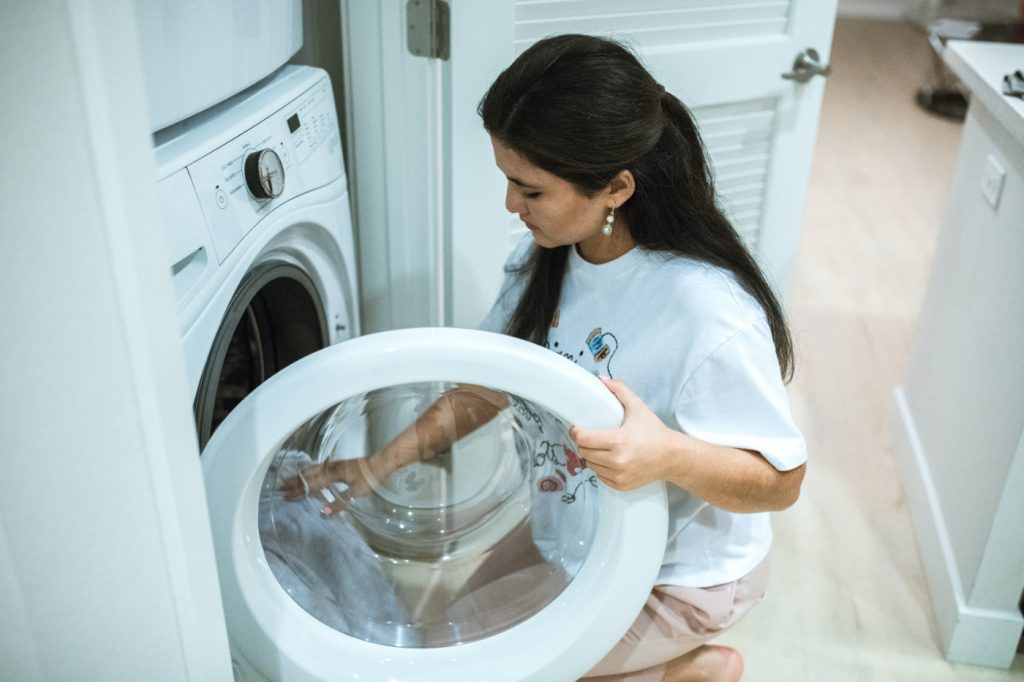
Are you finding it challenging to clean your weighted blanket? It’s perfectly normal to feel a bit perplexed, as these blankets need special care compared to standard ones. Fear not, for this guide is here to assist you, offering step-by-step advice on how to wash a weighted blanket without risking any harm.
Keep reading to unveil the secrets of maintaining your cozy sleep companion in a clean and refreshing state!
Key Takeaways
- Wash your weighted blanket as often as regular comforters or blankets. Usually once every few weeks, if used nightly.
- Spot clean stains before washing the entire blanket to prevent them from setting in and causing permanent marks.
- Choose the right washing method based on fabric and filler materials, such as machine washing for some blankets or hand washing for others.
- Use a gentle cycle with cold water and mild detergent when machine washing a weighted blanket.
Tips for Washing a Weighted Blanket
To maintain the cleanliness and quality of your weighted blanket, it’s essential to understand both the frequency of washing and the proper stain pre-treatment techniques. Selecting the correct washing method is equally crucial in preserving its overall quality.
How Often to Wash a Weighted Blanket
As a general guideline, weighted blankets should be cleaned as regularly as standard comforters. Typically around once every few weeks if used on a nightly basis. In the event of accidental spills or unexpected stains, immediate spot cleaning is essential.
Proper maintenance of a weighted blanket involves following washing instructions diligently to preserve its quality and extend its lifespan. Depending on the fabric and filler material, machine washing may be suitable for some blankets. While hand washing methods might be more appropriate for others.
The key to ensuring the longevity of your weighted blanket and keeping it fresh and cozy is consistency in maintaining its cleanliness. Frequent cleaning prevents the accumulation of dirt and helps your blanket stay comfortable for longer!
Pre-treating Stains
Pre-treatment of stains is a crucial step in the process of cleaning a weighted blanket. Initially, it is imperative to determine the nature of the stain. Which can vary from common food spills to organic stains such as bodily fluids. Each type of stain necessitates a tailored approach for effective removal.
For minor stains, a spot-cleaning method employing a mild soap or detergent may suffice. However, once you have identified and treated the stain, it is essential to thoroughly rinse it with either cold or warm water. Special attention should be paid to organic stains before proceeding to wash the entire blanket. This initial rinsing of problem areas prevents them from becoming deeply embedded in the fabric fibers. Thus averting the formation of stubborn, permanent marks.
Utilizing an efficient stain remover can significantly simplify this process and guarantee that your weighted blanket maintains its pristine appearance for an extended period.
Choosing the right washing method
It’s important to choose the right washing method for a weighted blanket.
- Evaluate the fabric and filler materials of your blanket.
- Check the care label on your blanket for specific washing instructions.
- Decide between taking it to the cleaners, machine washing or hand washing, depending on the blanket’s construction and weight.
- Use a gentle cycle with cold water if choosing machine wash.
- Opt for spot cleaning with mild soap and warm water for small stains.
- Choose a mild detergent without bleach to protect the integrity of your blanket.
- If your blanket is too heavy or delicate, consider using professional cleaning services.
- Always air dry your weighted blanket after washing to maintain its structure and prevent damage from high heat.
- Wash it 3 – 4 times per year but do more frequent washes when needed, like after spills or stains appear on the fabric.
Taking it to a Professional Cleaner
Taking your weighted blanket to a professional cleaner is the easiest method for ensuring it is properly cleaned and maintained.
This is the Easiest Method
Having your weighted blanket professionally cleaned is the most straightforward and effective method, especially if it exceeds 20 pounds in weight. Professional laundry services possess the expertise and specialized equipment required to handle heavier blankets with precision.
By adhering to their recommended washing instructions and guidelines, you can guarantee that your weighted blanket receives the meticulous care it demands, all without any added inconvenience or exertion on your part.
If you’re seeking a hassle-free and convenient approach to maintaining the cleanliness and freshness of your weighted blanket, seriously contemplate entrusting it to a professional cleaner for regular upkeep.
Machine Washing a Weighted Blanket
To machine wash a weighted blanket, start by selecting a gentle cycle and cold water temperature to prevent damage.
Selecting the Appropriate Cycle and Water Temperature
Machine washing a weighted blanket requires careful consideration of the cycle and water temperature to ensure proper cleaning without causing any damage. It is recommended to use a gentle cycle for washing the blanket, as this will help prevent fabric shrinkage and maintain its overall quality.
When it comes to water temperature, cold water is generally the best option for most weighted blankets. However, if you have a specific type of material or filling that requires warm water, make sure to select an appropriate wash cycle with suitable temperature settings.
By choosing the right cycle and water temperature, you can effectively clean your weighted blanket while preserving its longevity and performance.
Using a Mild Detergent
When washing a weighted blanket, it is crucial to use a mild detergent that is gentle on the fabric and safe for your skin. Avoid using harsh chemicals like bleach or fabric softener, as they can damage the integrity of the blanket and affect its effectiveness.
Look for detergents that are bleach-free and free of harmful chemicals such as chlorine. Mild detergents, like Tide, are recommended for glass bead-filled weighted blankets. Opt for nontoxic, eco-friendly options that are fragrance-free and hypoallergenic if you have sensitive skin or allergies.
A natural, allergen-free, plant-based detergent would also be a great choice. Taking care with your choice of detergent will help ensure that your weighted blanket stays clean without causing any harm or irritation to you or the blanket itself.
Drying the Blanket Properly
Properly drying a weighted blanket is essential to maintain its quality and prolong its lifespan. After machine washing, it is recommended to dry the blanket in a dryer on a low heat setting.
It’s important to monitor the drying process closely because weighted blankets may dry much faster than regular blankets due to their dense filling. Tumble drying at a low setting can also be an effective way to dry the blanket thoroughly.
For those who prefer air drying, laying the blanket flat can help protect it from wear-and-tear while preventing lumps from forming. Ultimately, choosing the right drying method will ensure that your weighted blanket stays soft, comfortable, and ready for use whenever you need it most.
Hand Washing a Weighted Blanket
To hand wash a weighted blanket, start by making a cleaning solution with mild detergent and warm water.
Making a Cleaning Solution
To prepare a cleaning solution for hand washing a weighted blanket, it’s best to use a mild detergent without bleach or fabric softener. Many weighted blankets cannot withstand hot water, so it’s recommended to use cold or warm water for the cleaning solution.
When dealing with glass bead blankets, opt for cold water and a gentle laundry detergent without bleach. Take into consideration the type of filler used in your blanket when choosing the appropriate cleaning method.
Submerging and Cleaning the Blanket
To hand wash a weighted blanket, begin by filling a large basin or bathtub with lukewarm water and adding a mild detergent. Submerge the blanket completely and utilize your hands to massage it for several minutes, with particular attention to any stains or soiled areas.
While massaging, be prepared to replace the soiled water with fresh water as necessary. Once you are confident that the blanket is clean, thoroughly rinse it under running water until all remnants of detergent are eliminated.
Gently squeeze out excess water without wringing or twisting the fabric, and subsequently lay it flat on a clean surface to air dry.
Rinsing and Drying the Blanket
After hand washing your weighted blanket, it’s crucial to thoroughly rinse and dry it to ensure proper cleanliness and maintenance. Start by gently wringing out any excess water from the blanket before moving on to rinsing.
Use lukewarm water to remove any remaining soap or cleaning solution, making sure every part of the blanket is thoroughly rinsed. Once you’re satisfied with the rinse, squeeze out as much water as possible without twisting or pulling on the fabric.
Finally, lay the blanket flat to air dry in a well-ventilated area or use a low-heat setting on your dryer if it’s permissible for your specific weighted blanket. Remember that proper drying techniques are essential for keeping your weighted blanket in top condition for long-term use and enjoyment.
Care Instructions for Different Fabrics and Filler Materials
The care instructions for different fabrics and filler materials in a weighted blanket can vary significantly. It is of utmost importance to consult the care label on your specific blanket to determine the appropriate washing method.
Some fabrics, such as cotton or microfiber, may be suitable for machine washing, while others may require hand washing or even professional dry cleaning.
For machine-washable blankets, follow these steps to preserve the fabric’s integrity:
- Machine Selection: Use a gentle cycle and opt for cold water to prevent any potential fabric damage.
- Detergent Choice: Use a mild laundry detergent that doesn’t contain bleach or fabric softeners. These additives can harm the fabric and its fillers over time.
- Protection During Wash: It’s highly recommended to place the weighted blanket inside a pillowcase or laundry bag. This extra layer of protection safeguards the blanket during the wash cycle.
If you need to hand wash your weighted blanket, follow these guidelines:
- Prepare Cleaning Solution: Create a cleaning solution using cool water and a mild detergent.
- Submerge and Gently Agitate: Submerge the blanket in the solution and gently agitate it to remove dirt and stains. Take care not to wring or twist the fabric, as this can damage it.
- Rinse Thoroughly: Rinse the blanket thoroughly with cold water until all soap residue is gone.
In the case of weighted blankets containing fillers such as rice, beans, or grains, it’s usually best to opt for dry cleaning. These fillers can become damaged or clump together if exposed to water.
By diligently following these care instructions tailored to your fabric type and filler material, you can ensure that your weighted blanket remains clean and in excellent condition for many years to come.
Conclusion
In conclusion, maintaining the cleanliness and quality of your weighted blanket is a crucial part of ensuring a cozy and refreshing sleep experience. Regular cleaning, spot treating stains, and choosing the right washing method based on fabric and filler materials are all essential steps in preserving your blanket’s lifespan. Whether you opt for professional cleaning services, machine washing, or hand washing, the key lies in consistency and attention to detail. Always use a mild detergent, avoid harsh chemicals, and pay heed to drying techniques. By following these guidelines and understanding the unique care requirements of your weighted blanket, you can enjoy its warmth and comfort for many years to come, ensuring a peaceful night’s sleep whenever you need it most.
